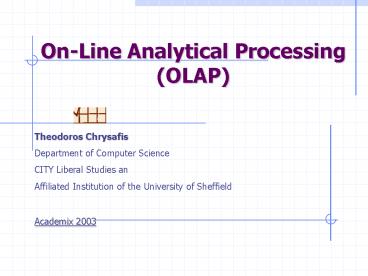On-Line Analytical Processing (OLAP) - PowerPoint PPT Presentation
1 / 17
Title:
On-Line Analytical Processing (OLAP)
Description:
CITY Liberal Studies an. Affiliated Institution of the University of Sheffield. Academix 2003 ... Security How easy the end user can access unauthorised data? ... – PowerPoint PPT presentation
Number of Views:77
Avg rating:3.0/5.0
Title: On-Line Analytical Processing (OLAP)
1
On-Line Analytical Processing(OLAP)
Theodoros Chrysafis Department of Computer
Science CITY Liberal Studies an Affiliated
Institution of the University of
Sheffield Academix 2003
2
Contents
- Introduction
- Decision Support Systems
- On-Line Analytical Processing (OLAP)
- OLAP Taxonomy
- MOLAP
- ROLAP
- HOLAP
- DOLAP
- Conclusion
3
Introduction
- What is
- On-Line A process controlled by a computer.
- Analytical Processing needs Analytical Data.
- Analytical Data Data that involve analysis.
- Analytical Data consist of Business Data.
- Business Data Time, Customers, Sales, Stores,
Products, etc.
4
Decision Support Systems
- Decision Support Systems (DSS) can defined in two
ways - By describing the software tools or the
technologies we use to perform business
decisions. - OR
- By describing the function or the concept of
Decision Support Systems in a tool neutral way.
5
Decision Support Systems
- Definition of DSS by Erik Thomsen
- The activity of using logic-based
fact-processing rules in combination with
goal-oriented management rules with or without
human intervention to translate larger sets of
lower-level facts and fact relationships into
smaller sets of higher-level facts and fact
relationships (and vise versa).
Client
Analytical Processing
Analytical Data
Business Data
6
Decision Support Systems
- DSS treats facts and rules differently. This
treatment groups DSS in the following categories - Data Mining Tools - Discover rules that explain
relationships between facts. - OLAP Tools - organise facts according to multiple
dimensions and they use powerful rules for
combining those facts to form aggregate facts. - Business Modeling Tools - organise the management
and the expert tools. - Data Visualisation Tools - graphically illustrate
relationships between facts.
7
Data Dimensionality
Customers
Sale
- Possible Views of Sale
- How many Products sold at Time to specific
Customer(s)? - How many Customers bought at specific Time the
Product(s)? - At which Time(s) the Customer(s) bought the
specific Product(s)?
- Products
Time
8
On-Line Analytical Processing
- On-Line Analytical Processing (OLAP) definition
by OLAP Council - A category of software technology that enables
analysts, managers and executives to gain insight
into data through fast, consistent, interactive
access to a wide variety of possible views of
information that has been transformed from raw
data to reflect the real dimensionality of the
enterprise us understood by the user.
Security
Interactivity
Customisation
Visualisation
OLAP
9
On-Line Analytical Processing
- OLAP functionality provides dynamic
multi-dimensional analysis, supporting analytical
and navigational activities. - OLAP functionality is provided by the OLAP
Server. - OLAP Council defines OLAP Server as A high
capacity, multi-user data manipulation engine
specifically designed to support and operate on
multi-dimensional data structures.
10
On-Line Analytical Processing
- OLAP Taxonomy
- Multi-dimensional OLAP (MOLAP)
- A k-dimensional matrix based on a non relational
storage structure. Agrawal et al. - Relational OLAP (ROLAP)
- A relational back-end wherein operations of the
data are translated to relational queries.
Agrawal et al. - Hybrid OLAP (HOLAP)
- Integration of MOLAP and ROLAP.
- Desktop OLAP (DOLAP)
- Provides a specific cube for analysis. Simplified
version of MOLAP or ROLAP.
11
On-Line Analytical Processing
- MOLAP
- Multi-dimensional data management in
Multi-Dimensional Database Management Systems
(MDDBMS). - Advantages Fast data access, many dimensions,
performance. - Further Research on storage techniques and
realisation of transactional concepts.
12
On-Line Analytical Processing
- ROLAP
- A multi-dimensional user view on relational data
storage using Star or Snowflake Database Schemata.
Region Dimension
Customer Dimension
Product Dimension
Time Dimension
Snowflake Schema
13
On-Line Analytical Processing
- ROLAP
- Advantages Easy to understand, easy to model,
easy to implement. - Further Research on dynamic optimisation, on
meta-models, on functional extensions for the
ROLAP engines, on user-defined functions for the
OLAP.
14
On-Line Analytical Processing
- HOLAP
- A system, which supports (and integrates)
multi-dimensional and relational storage for data
in an equivalent manner in order to benefit from
the corresponding characteristics and
optimisation techniques. Dinter et al. - Advantages use of best techniques introduced on
MOLAP and ROLAP, transparency between MOLAP and
ROLAP systems. - Further Research on storage systems, on global
multi-dimensional schema, on common interface and
mutual integration of MOLAP and ROLAP.
15
On-Line Analytical Processing
- Conclusion
- OLAP Tools are Market Driven. That is, no
standards either academic or from an organisation
exist. - A common model approach is to use Star or
Snowflake Database Schemata (common in Data
Warehouse Modeling). - Reviews contain many technical issues resulting
difficulties to understand while a candidate end
user needs information about a candidate product. - Hence, we advice candidate end users to look for
the following, independent tool architecture or
vendor, characteristics.
16
On-Line Analytical Processing
- Conclusion
- Interactivity How easy the end user interacts
with the tool? - Customisation How easy the end user make
changes on the data representation provided by
the tool? - Security How easy the end user can access
unauthorised data? - Visualisation How easy the tool provide
multi-dimensional graphical representations?
17
Thank you for your attention!
Any Questions?































